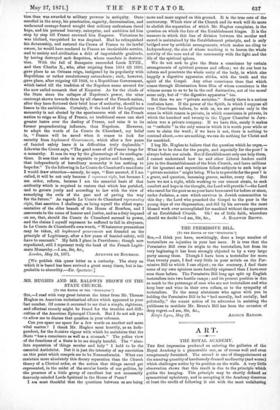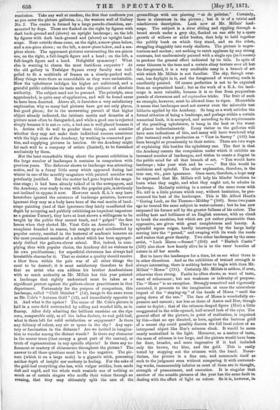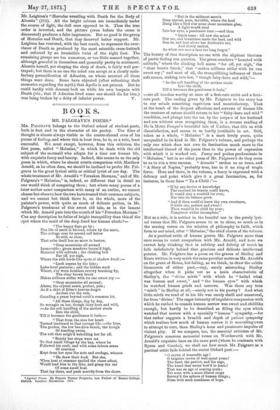A RT.
THE ROYAL ACADEMY.
THE first impression produced on entering the galleries of the Royal Academy is a pleasurable one, as of rooms well and even sumptuously furnished. The second is one of disappointment at the amazing quantity of handsomely-framed mediocrity (and worse) which challenges notice by its position on the walls. A very little observation shows that this result is due to the principle which guides the hanging. This principle may be shortly defined as symmetrical upholstery, and in accepting it the Academy deserves at least the credit of following it out with the most unfaltering
resolution. Take any wall at random, the first that confronts you as you enter the picture galleries, i.e., the western wall of Gallery
No. 2. The centre is formed by a large pseudo-classicism, sur-
mounted by dogs. These are flanked on the right by figures with dark back-ground and (above) an upright landscape ; on the left by figures with dark back-ground and (above) an upright land- scape. Next outside these come, on the right, a snow-piece below, and a sea-piece above ; on the left, a snow-piece below, and a sea- piece above. The uppermost pictures surmounting the sea-pieces are, on the right, a full-length figure and a head ; on the left, a full-length figure and a head. Delightful symmetry ! What else is wanting to charm the most fastidious carpenter ? At the old gallery in Trafalgar Square every faculty was cud- gelled to fit a multitude of frames on a closely-packed wall. Many things were there as unavoidable as they were undesirable. Now the upholsterer indulges his higher art unfettered, and a grateful public cultivates its taste under the guidance of absolute authority. The subject need not be pursued. The principle, once apprehended, is quite easy of application, and will be found never to have been deserted. Above all, it furnishes a very satisfactory explanation why so many bad pictures have got not only places,
but good places; for in the unwavering pursuit of that higher object already indicated, the intrinsic merits and demerits of a
picture must often be disregarded, and while a good one is rejected simply because it is not en suite, a bad one is well placed because it is. Artists will do well to ponder these things, and consider whether they may not make their individual success consistent with the high aims of the Academy, by working in concerted par- ties, and supplying pictures in batches. Or the Academy might let each wall to a company of artists (limited), to be furnished exclusively by them.
Not the least remarkable thing about the present exhibition is the large number of landscapes it contains in comparison with previous years. The disfavour shown to landscape was attracting notice, and in a funny little essay which appeared during last winter in one of the monthly magazines with painted outsides was petulantly justified. But the matter had gone beyond the maga- zine stage ; it had been already talked of in the newspapers, and the Academy, ever ready to run with the popular gale, is obviously not inclined to oppose it now. However much R.A.'s may have heretofore ignored the existence of landscape painters, however ignorant they may as a body have been of the real merits of land- scape painting (and of that ignorance they lately manifested the depth by accepting and publicly exhibiting an impudent imposture as a genuine Turner), they have at least shown a willingness to be taught by the public they cannot teach, and "gulped" the first lesson when they elected Mr. Vicat Cole an Associate. Thus a complaint founded in reason, but caught up and misdirected by popular outcry, resulted in the bestowal of academic honours on the most prominent member of a school which has been appropri- ately dubbed the gallows-clever school. But, indeed, in com- plying thus with popular choice, the Academy did no violence to its own predilections ; for superficial cleverness has always had irresistible charms for it. That so sinister a quality should receive a blow from within the pale was of all other things the most to be desired ; it is most satisfactory therefore to find that an artist who can address his brother Academicians with so much authority as Mr. Millais has this year painted a landscape that rightly understood must be taken as a significant protest against the gallows-clever practitioners in that department. Fortunately for the purpose of comparison, this landscape, called "Chill October" (14), hangs in the same room as Mr. Cole's "Autumn Gold" (52), and immediately opposite to it. And what is the upshot? The scene of Mr. Cole's picture is laid in a corn-field surrounded by rolling and wooded hills, as in Surrey. After duly admiring the brilliant sunshine on the ripe corn, comparable only, as all the ladies declare, to real gold-leaf, what is there left for solid satisfaction or enjoyment? Is there any delicacy of colour, any air or space in the sky ? Any mys- tery or fascination in the distance ? Are we invited in imagina- tion to wander among the distant woods ? Is there any character in the nearer trees (that occupy a great part of the canvas), or truth of representation in any specific objects? Is there any re- finement or mastery of chiaroscuro throughout the picture? The answer to all these questions must be in the negative. The pic- ture (which is on a large scale) is a gigantic trick, possessing neither depth of insight nor modesty in feeling. For the sake of the gold-leaf everything else has, with vulgar artifice, been made dull and vapid, and the whole work reminds one of nothing so much as of certain singers who muffle their voices through an evening, that they may ultimately split the ears of. the groundlings with one piercing " ut de poitrine." Certainly,. there is cleverness in the picture ; but it is of a trivial and= mischievous description. Look now at Mr. Millais' land- scape. The subject is a river sliding and rippling through a-
broad strath under a grey sky, flanked on one side by a spare growth of willows or alder bushes, that help to hold together the pebbly bank on which they stand, and on the other„ straggling sluggishly into reedy shallows. The picture is unpre- tentious and modest ; not seeking to catch applause by any strong
contrasts, but unobtrusively painted with a single eye (as it seems) to produce the general effect indicated by its title. In spite of some thinness in the tone and a certain slimy texture over all but. the foreground, it is a very creditable essay in a branch of art,
with which Mr. Millais is not familiar. The sky, though over- cast, has daylight in it, and the foreground of wavering reeds is.
excellentlypainted. Of course perfection is not to be expected from an unpractised hand ; but as the work of a R.A. the land- scape is most valuable, because it is so free from purposeless-.
parade of cleverness and ad eaptandunt tricks. The fruit of such an example, however, must be allowed time to ripen. Meanwhile-
it seems that landscapes need not answer even the miserable test
hitherto applied by the Academy. So long as a work satisfies the- formal criterion of being a landscape, and perhaps within a certain.
numerical limit, it is accepted, and according to the requirements of the presiding upholsterer, is hung in the best or the worst. of places indiscriminately. Every visitor to the galleries will have seen indications of this, and many will have wondered why (for instance) such a production as "View in Surrey" (449) has. been brought so prominently to their notice. There are two ways.
of explaining this besides the upholstery one. The first is that.
the Academy resents the compulsion under which it exhibits an, increased number of landscapes, and wishes to create a disgust in.
the public mind for all that branch of art. "You would have- landscape ; take your wish and be —." But this would be- malicious and spiteful. The other explanation, therefore, is tha- t/lie one, viz., pure ignorance. Once more, therefore, a hope may be expressed that Mr. Millais will help his blinder brethren to- learn what they ought, and what they ought not, to admire in landscape. Modestly retiring in a corner of the same room with.
No. 449 is a little picture which may, without hesitation, be pro- nounced the best of the landscapes. This is Mr. Alfred Hunt's- " Goring Lock, on the Thames—Midday" (506). Some two years.
agohe treated the same subject in water-colours ; but he has now surpassed his former self by the greater fullness of his colour. The- midday heat and brilliance of an English summer, with no clouct, to break the sunshine, but which are yet rather pleasurable thatv oppressive, are given with great completeness and beauty. A_ splendid repose reigns, hardly interrupted by the barge lazily- moving into the "pound," and swaying with its wash the reeds-. and rushes that grow thereby. Two other landscapes by the same- artist, "Loch Maree —Sunset" (304) and " Harlech Castle"' (528) also show how keenly alive he is to the rarer beauties of nature in all her moods.
But to leave the landscapes for a time, let us see what there is-. in other directions. And as the exhibition of trained strength is always interesting, there is nothing better to begin with than Mr..
Millais' " Moses " (191). Certainly Mr. Millais is seldom, if ever,. otherwise than strong. Faults he often shows, as want of taste,
want of refinement ; but not weakness or infirmity of purpose.- The "Moses" is no exception. Strongly conceived and vigorously executed, it presents to the imagination at once the miraculous.
import of the "staying-up" of the hands of Moses "until the' going down of the sun." The face of Moses is wonderfully ex- pressive and earnest ; nor less so those of Aaron and Her, though. easier to depict ; that of the crimson-draped figure (Liar) a little- exaggerated in the wide-opened, half-scared look of the eyes. The general effect of the picture, in point of realization, is impaired, by this—that no eye directed, as here, against the lustrous gold: of a sunset sky could possibly discern the full local colour of an interposed object like Hues crimson cloak. It would be more- nearly neutralized in the light. Moreover, as a matter, of taste,.
the mass of crimson is too large, and the picture would have been. far finer, broader, and more impressive if it had included. onlythe brown, the blue, and the gold. This is easily tested by stopping out the crimson with the hand. Never- theless, the picture is a fine one, and commends itself as. such to the judgment even without comparing it with surround- ing works, immeasurably inferior as most of these are in thought,. strength of presentment, and execution. It is singular that, another of the notable pictures of the year has the same fault in. dealing with the effect of light on colour. So it is, however, in, Mr. Leighton's "Hercules wrestling with Death for the Body of Alcestis" (215). All the bright colours are immediately under the source of light, the dull ones opposed to it. Thus the true .order is inverted, and the picture (even before the cause is discovered) produces a false impression. But so good is the group -of Hercules and Death, that they deserved better support. Mr. Leighton has ventured, with the best result, to represent the over- throw of Death as produced by the most scientific cross-buttock and enforced by an irresistible twist of the right foot. The remaining groups are too numerous, or too little massed together, although graceful in themselves and generally pretty in sentiment. Alcestis herself, yet sleeping the sleep of death, is fairly well por- trayed; but there is no one the mind can accept as a clearly satis- factory personification of Admetus, on whose account all these things were done. Some have objected (after refreshing their memories regarding the myth) that Apollo is not present. But he .could hardly with decency look on while his own bargain with Death (viz., that if Admetus lived some one should die for him,) was being broken by a deity of inferior power. V.




































 Previous page
Previous page